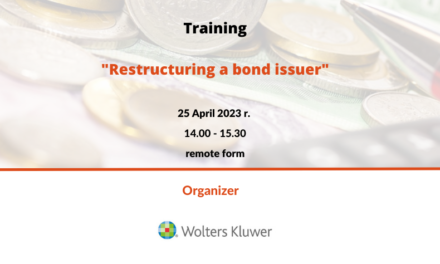
Possible consequences of non-implementation of the Preventive Restructuring Framework Directive

Implementation of the Preventive Restructuring Framework Directive on time is not feasible. What are the consequences to be reckoned with?
Poland must implement Directive 2019/1023 of the European Parliament and of the Council (EU) of 20 June 2019 on the framework for precautionary restructuring (…) any day now. This is one of the major challenges facing the Polish legislator in 2022 in the field of insolvency and restructuring law. While significant amendments and constant changes to the law (including amending it after a few months) are something to which everyone is probably already accustomed, the changes imposed by the directive, depending on the choices made by the member state, may strongly tilt the balance towards stronger protection of creditors’ or debtor’s interest.
Not much time left
According to Article 34(1) and (2) of the Directive, we should implement it by 17 July 2022 (the deadline of 17 July 2021 extended by one year under Article 34(2)). With few exceptions, this provision makes it mandatory to both “adopt,” “publish,” and “apply” the new rules by that date (Article 34(1), sentences 1 and 2).

As of the date of this writing, May 26, 2022, there are only 52 days left until the final date of implementation of the Directive. Meanwhile, we still do not know the content of the draft implementing the new regulations, let alone their adoption or the public consultations anticipated in the legislative process.
There is no doubt that to a large extent the directive provides for changes in institutions that are of fundamental importance for the course of the entire restructuring process. These include, first of all, temporary limitations of protection against enforcement (Articles 6 and 7) and changes in the rules for accepting arrangements against objections of a group of creditors (Article 11). They affect practically every proceeding.

An impossible task
It can be assumed without much doubt that implementation of the Directive in such a way that its provisions are ‘applicable’ (Article 34.1, second sentence) from 17 July 2022 is an impossible task. They are particularly mindful of the current incomplete operation of the National Debt Register (KRZ) and the dynamics of the changes introduced to it.
The IT system has not even been fully adjusted to today’s regulations yet. On the other hand, not only have future regulations not yet been enacted, but we do not even know their contents. It can therefore be concluded with a high degree of certainty that Poland has not implemented the Restructuring Framework Directive by the required deadline within the meaning of the second sentence of Article 34.1. Even if the regulations come into force, but cannot be applied in the NCA, this is unlikely to be considered proper implementation of the directive.
The finding that Poland has failed to implement the EU Directive on time raises many important and difficult questions. These fall under the general heading of non-implementation or incorrect implementation of an EU Directive by a Member State. This is an issue that most lawyers dealt with at the beginning of their studies. Of course, I am mainly concerned with the consequences for the participants in economic transactions, and not with the potential reactions of the European Commission (EC).
Consequences of non-implementation
First of all, failure to implement the directive may open the door to the problem of vertical application of directly effective provisions of the directive and payment of damages for late implementation (see e.g. https://www.rp.pl/prawo-dla-ciebie/art2872361-nieprawidlowe-wdrozenie-dyrektywy-skutki-dla-podmiotow-prywatnych, https://eur-lex.europa.eu/legal-content/PL/ALL/?uri=LEGISSUM:l14547). At first glance, it is not unlikely that a dispute will arise out of a situation where, under the rules applicable under Polish law, an agreement has not been adopted but, under the rules of the directive, it would have been adopted, or vice versa. Will there then be proceedings before the courts and questions to the CJEU as to whether the provisions of the directive are clear and precise enough to be applied directly? Will there be proceedings concerning the State Treasury’s liability for untimely implementation of the directive? This is possible in a situation where someone considers that they have suffered damage as a result of delays in its implementation, because under the directive their obligations would be effectively reduced.
Paradoxically, we are saved by the fact that in many places the directive gives member states broad autonomy over implementation options. It offers various options for the implementation of particular regulations. This significantly reduces the pool of regulations that can be considered sufficiently precise to be directly applicable or to be the basis for liability for damages.
Need for consultation
One thing remains constant. The legislature has consistently and steadfastly ensured that restructuring and bankruptcy lawyers have something to do, think about and write about. Bearing in mind how often successive amendments to the acts on bankruptcy and restructuring law appear, a longer and broader public consultation on the implementation model of the directive would certainly be useful. However, given the timetable, this is unlikely to happen.













